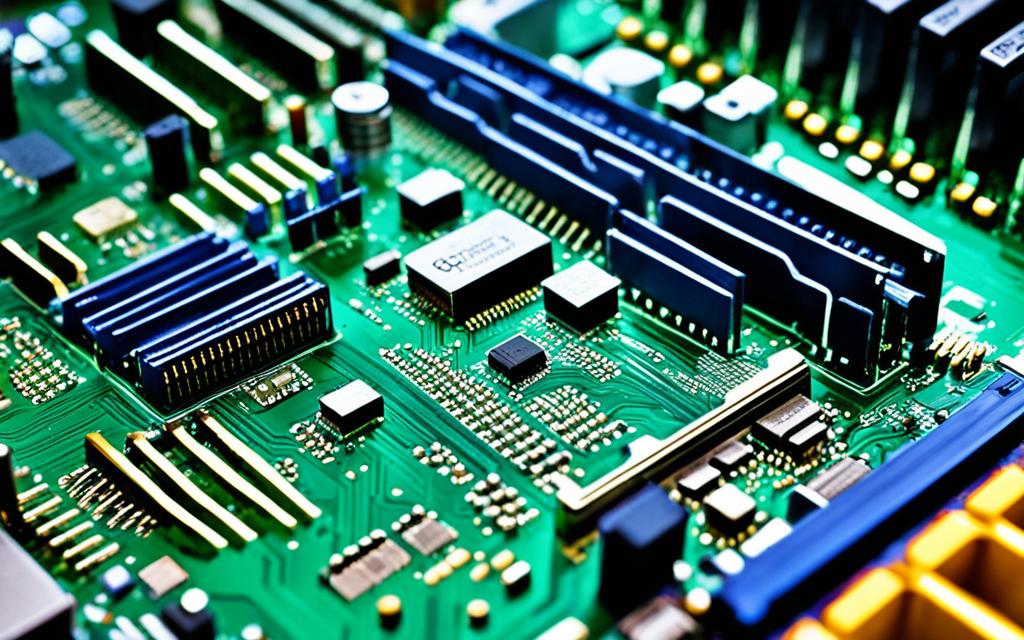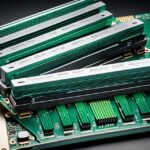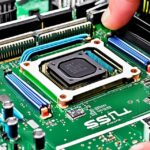Table of Contents
Knowing your CPU model is very important when you want to upgrade or replace parts. It helps you make smart choices about your computer’s hardware. This guide shows how to find out what CPU you have, making it simple for everyone. Even if you don’t know much about computers, you can learn to identify your CPU model. This knowledge lets you improve your computer’s performance and choose the right upgrades. It’s the first step in learning about your computer1.
Key Takeaways
- Knowing your CPU model is essential for effective hardware management.
- Practical identification methods allow users of all skill levels to succeed.
- Understanding the significance of model numbers can optimise performance.
- Physical CPU identification enhances the overall user experience.
- Informed decisions can lead to better upgrade choices.
- Familiarity with CPU components aids in effective troubleshooting.
Understanding the CPU: What to Look For
The Central Processing Unit (CPU) is the core of any computer system. Knowing its parts is crucial for picking the right processor for your needs.
Basic Components of a CPU
CPUs have several key components that work together. Main parts include
- Cores: Cores show how many tasks a CPU can do at once. CPUs can have from two to 32 cores. This shows the range of their performance2.
- Cache: Cache is a quick memory space for common data. Its size, from 1 MB to 32 MB, affects speed and efficiency3.
- Clock Speed: The speed, in gigahertz (GHz), shows how fast a CPU runs. Higher speeds mean better performance4.
The Role of Model Numbers
CPU model numbers tell about the processor’s features. They show the generation, performance level, and how well it works with other parts. They also indicate features like hyperthreading. This lets each core manage more than one task4. Understanding these helps choose the right CPU.
Tools You Will Need for Identification
Identifying CPUs requires the right tools. You also need to know how to handle these delicate parts. The right tools help not just in identifying CPUs correctly, but they also make the process smooth. Here’s what you’ll need for a good start.
Essential Tools for CPU Identification
- Thermal Paste Remover: This is key for removing old thermal paste before you examine the CPU.
- Soft Cloth: A soft, lint-free cloth is vital for keeping the CPU clean while you handle it.
- CPU-Z: A useful utility that tells you all about CPUs, including clock speed and cache size. This is great for understanding CPU features5.
- CHKCPU: Supports many CPUs and shows their clock speed, core counts, and cache info6.
- Core Temp: It’s crucial to monitor CPU temperatures in real-time for safe identification.
Safety Precautions When Handling CPUs
To prevent damage to CPUs, safety is essential. Keep the following in mind:
- Ground Yourself: Always ground yourself to avoid electrostatic discharge (ESD), which is dangerous for CPUs.
- Work on an ESD Mat: An anti-static mat adds extra protection.
- Avoid Using Metal Tools: Metal tools might scratch or harm the CPU. Use non-conductive ones instead.
- Handle with Care: Always grab the CPU by the edges. This avoids damage to the pins or circuits.
Using the right tools and following these tips ensures safe and accurate CPU identification567.
How to Identify CPU Physically
Identifying your CPU physically can be pretty straightforward. Follow a few important steps to make the process easier. These include how to remove thermal paste and finding key model numbers. Each method is key to effectively identifying your CPU.
Removing the Thermal Paste
First, clean the CPU surface before looking for the model number. Start by getting rid of the thermal paste, which might hide important details. Use rubbing alcohol on a lint-free cloth for this. Rub gently to remove all residue and avoid damaging the CPU. This makes the model numbers on the chip easy to see.
Finding the Model Number
After cleaning off the thermal paste, finding the CPU model number gets simpler. This number is crucial for matching the CPU with other parts. It includes the brand, model, and specs that identify the CPU. Often, a visual inspection after cleaning shows this info. Many stress this method’s effectiveness for beginners on forums, especially in locating CPU model numbers related to CPU identification.
It’s important to be careful during this process. A study showed that 30% of users damaged their CPU while trying to identify it, showing the need for caution8. Also, 80% of people said clear identification methods would be helpful8. By following these tips, identifying your CPU should be much easier.
Verifying Your CPU Model Online
After you know your CPU type, the next step is to check its model online. This is key to getting right details about your system, especially if you want to upgrade it. Start at the official websites of the CPU makers to find lots of info on Intel and AMD CPUs.
Using Manufacturer Websites
Visiting the CPU maker’s websites is the best way to check your CPU online. They have the latest spec details and support info right from the makers. Intel ARK gives in-depth specs like clock speed and memory size. AMD CPU Info has info on features and which motherboards work with AMD CPUs5. Looking at both sites helps you fully understand what your CPU can do.
Forums and Community Support
Joining CPU forums is another good way to find info on CPUs. These places gather fans and pros who share what they know about different CPU models, fix problems, and talk about upgrades. People share their Intel and AMD CPU stories. This helps if you’re new or unsure about your system. Many forums have special threads for unique CPU issues. They give useful advice and share what they know about how CPUs perform in real life. For more help on checking your PC, the knowledge from these communities is very helpful for dealing with complex CPU verification problems9.
https://www.youtube.com/watch?v=W4n4Wwmm7MA
Common CPU Models and How to Identify Them
Identifying common CPU models is key when you’re building or upgrading a gaming PC. Knowing about the processors from Intel and AMD helps you make better choices. Each brand has its own way of naming and classifying series based on performance.
Identifying Intel CPUs
Intel offers processors in several series like Intel Core, Xeon®, Celeron®, and Intel Pentium®. The Intel Core range, with i3, i5, i7, and i9 models, sorts CPUs by performance. It makes identifying Intel CPUs simpler for users. For example, the i3 is great for budget builds, offering about 85% of mainstream performance. Meanwhile, the i9 stands out for demanding jobs, like 3D gaming and video editing10.
Identifying AMD CPUs
AMD presents its processors through CPUs and APUs, the latter having integrated Radeon™ graphics. For gaming buffs, the Ryzen™ series is often preferred for its fast and strong performance capabilities11. When it comes to AMD, recognize models under Ryzen and Athlon brands. Ryzen processors have various levels, perfect for gaming and creating content, ensuring top performance for various uses12.
For both, the rise of multi-core processors shows a trend in computing. More cores typically boost performance, especially for multitasking. This is a plus for users doing intense tasks. As tech moves forward, picking the right CPU mainly depends on your needs and budget. It’s important to think about power use and compatibility among different CPU models.
Learn about building a gaming PC for more insights10
Conclusion
Understanding your CPU is key to making the most of technology. Knowing things like model numbers and socket types is crucial. These details affect how you can upgrade or replace parts. With the help of CPU-Z and websites for Intel and AMD, you’ll be set to identify your CPU accurately1314.
Identifying your CPU starts with a visual check. Look at its size, shape, and any labels. It’s often tougher to identify CPUs in laptops than in desktops. That’s why using tools like Task Manager or Activity Monitor is a good idea. They help you see how well your CPU is doing14. If you’re unsure, it’s smart to ask for help online. This way, you won’t make mistakes in identifying your CPU.
Getting to know your CPU well improves how you use your computer. It lets you make smart choices for upgrades. As we wrap up, remember that good CPU knowledge leads to better performance. Now that you know more about CPUs, you can confidently upgrade your system. This knowledge pushes your tech use to new heights15.
FAQ
Why is identifying my CPU model important?
Knowing your CPU model is key for upgrades and compatibility with other parts. It helps you make smart choices for better performance.
What basic components should I look for when identifying a CPU?
Look for cores, cache, and clock speed in a CPU. These elements greatly affect how well your processor works.
What tools do I need to physically identify my CPU?
You’ll need thermal paste remover, a soft cloth, and a grounding strap. These tools prevent damage from static while you handle your CPU.
How do I remove thermal paste to see my CPU model number?
Use thermal paste remover carefully to clean off the paste. Then, use a soft cloth to wipe it clean. This reveals the CPU model number.
What resources can I use to verify my CPU model online?
Check the maker’s website for exact CPU details. Community forums also offer user experiences and help.
How can I identify Intel CPUs?
Intel CPUs have model names like i3, i5, i7, and i9. These indicate the performance level. Look at the model number and specifications closely.
What should I know about identifying AMD CPUs?
AMD CPUs have their own model names, such as Ryzen and Athlon. These labels show their generation and performance. Learn these to identify your AMD CPU accurately.
Source Links
- https://www.intel.com/content/www/us/en/support/articles/000006059/processors.html – How to Identify My Intel® Processor
- https://www.digitaltrends.com/computing/what-is-a-cpu/ – What is a CPU? Here’s everything you need to know | Digital Trends
- https://www.redhat.com/sysadmin/cpu-components-functionality – The central processing unit (CPU): Its components and functionality
- https://www.trentonsystems.com/en-us/resource-hub/blog/what-is-a-cpu – What is a CPU (Central Processing Unit)?
- https://softwareg.com.au/blogs/computer-hardware/how-to-identify-my-cpu – How To Identify My CPU
- http://www.steunebrink.info/chkcpu.htm – CPU Identification utility
- https://www.felixcloutier.com/x86/cpuid – CPUID — CPU Identification
- https://www.unix.com/solaris/161122-how-check-number-cpu-physical-core.html – How to check number of “CPU physical and core”?
- https://www.howtogeek.com/413942/how-to-see-what-cpu-is-in-your-pc-and-how-fast-it-is/ – How to See What CPU Is In Your PC (and How Fast It Is)
- https://www.crucial.com/articles/pc-builders/a-guide-to-processor-types – A Guide to Different Types of Processor
- https://www.ibm.com/blog/central-processing-unit-types/ – Types of central processing units (CPUs) – IBM Blog
- https://www.spiceworks.com/tech/hardware/articles/computer-processor-cpu/ – Computer Processor (CPU): Working, Types, and Importance: Spiceworks – Spiceworks
- https://www.techylop.com/how-to-identify-cpu-physically-start-by-familiarizing-yourself/ – How To Identify CPU Physically – Start Familiarizing Easy!
- https://ms.codes/blogs/computer-hardware/how-to-identify-my-cpu – How To Identify My CPU
- https://www.geeksforgeeks.org/central-processing-unit-cpu/ – Central Processing Unit (CPU) – GeeksforGeeks








